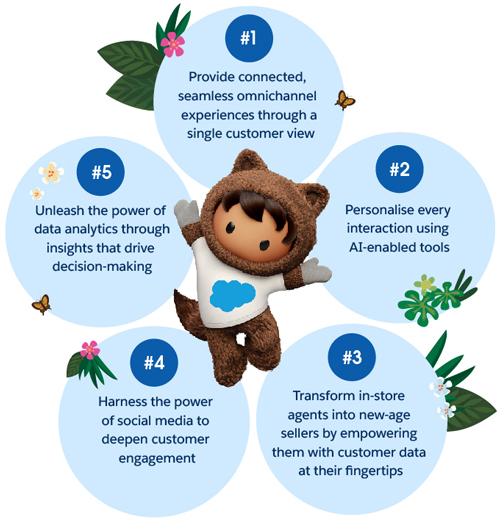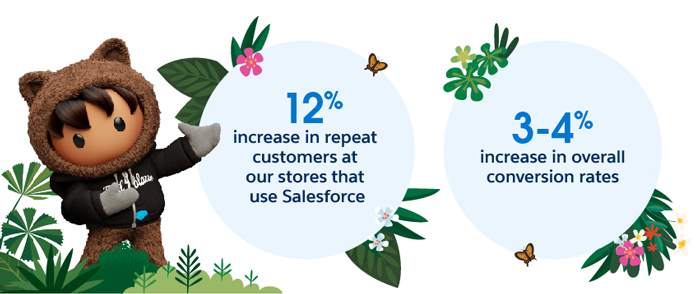Getting value for money is a given for today’s customers, so merely providing great products won’t cut it any longer. Customer focus is increasingly shifting from product quality and pricing to the overall experience a brand offers, whether online or offline. 86% of customers would even pay a premium for great customer experiences.
Businesses that understand and act upon this shift in consumer priorities are sure to succeed. The more convenient and valuable experiences you provide, the more likely you are to gain loyal customers who drive brand advocacy.
At Titan, we were fortunate to have started our digital transformation journey much before the pandemic. We realised that tightly weaving together online and offline customer journeys is the way forward. So, with this head start and Salesforce’s support, we quickly ramped up our digital presence to meet customers one-on-one even beyond our 1900 physical stores.
We are learning so much while striving to make customer experiences frictionless. Here are some lessons you too can benefit from:

1. Provide connected, seamless omnichannel experiences through a single customer view
Most customers today shop on the go, thanks to internet access and smartphones. These tech-savvy customers expect efficiency and convenience at every step of their journey. This includes being able to smoothly hop between different touchpoints without needing to repeat any processes or conversations.
Investing in technology that allows you to replace broken customer journeys with connected experiences will reduce inconvenience and attrition. We use Salesforce to track customer activity and engagements across touchpoints. This helps us provide frictionless, contextual experiences no matter where customers engage with us.
For instance, customers can browse or shop from the comfort and safety of their homes through our eCommerce sites and apps. But if anyone wants to try on an item or pick it up from a physical store, they can message us on WhatsApp or even talk to a live agent. Their information is shared with the nearest store so a sales agent there can help them complete the purchase over a video call or in person.
Using Salesforce Customer 360, we can also know if a customer is engaging with more than one of our brands or channels. This helps us create a single customer view across brands.
2. Personalise every interaction using AI-enabled tools
The importance of personalisation in providing a great customer experience cannot be emphasised enough. If your customers don’t feel special or heard, they can easily move on to another brand that meets their expectations.
Artificial Intelligence (AI) can make it easier to provide personalisation at scale. For instance, our in-store sales agents use AI-enabled next best actions to provide accurate product recommendations based on customers’ online activity and preferences. Similarly, our marketing teams use AI to understand what excites each customer, so no two customers receive the same campaign messaging. Communication is closely mapped to the customer persona and the product that will excite their interest.
3. Transform in-store agents into new-age sellers by empowering them with customer data at their fingertips
How consumers buy has changed, then how can brands continue to sell in the old way? Even brands with a predominantly offline presence can equip their in-store staff with the right technology and continual training to become digital-first, data-driven sellers. This means each salesperson at your offline stores can evolve into contact centre-like agents to connect with customers on any channel.
Many of Titan's customers still seek the assurance of human interactions and holding products in their hands, especially when buying high-value items. All of our data - like customers' past interactions and preferences - is consolidated on Salesforce. Our store staff and other employees can access this complete customer data in real-time on a mobile app. Knowing customers’ browsing and purchase history can help them cross-sell and upsell, while knowing their personal milestones can help the store staff personalise their interactions on the fly. This way, the new-age sales agent can provide the same level of attention and personalisation to every customer whether they walk into a store or request for virtual guided sales.
4. Harness the power of social media to deepen customer engagement
Social media platforms host a wealth of data about customers’ engagement patterns and their perception of brands. And because these platforms make connecting so easy and fun, social selling is quickly becoming the future of eCommerce.
Consider using tools that allow you to understand which trends customers are tracking and the brands they follow. When you know your customers’ real interests and preferences, you can take wonderful shopping experiences to their favourite social channels and connect with them over things they care about.
5. Unleash the power of data analytics through insights that drive decision-making
Data analytics tools can give you deeper visibility into your business’ performance and the insights to stay ahead of the curve. These insights can enable you to make informed business decisions based on data, instead of relying on your gut feeling.
At Titan, we have employed data analytics in every field and function, and set KPIs. For example, our sales teams use analytics to forecast sales accurately. Our marketing teams measure campaign success to identify highly engaged customers. Our product teams create new designs by fusing together different high-performing products. And our IT teams consistently gather data around customer interactions to develop cutting-edge communication tools. And all of this is made possible by using Tableau and other platforms to provide each team with powerful data analytics through easy-to-use, customisable dashboards.
We have been able to do all of the above with Salesforce. With products like MuleSoft, we could integrate more than 20+ third-party systems with Salesforce to give all our teams a complete, shared view of more than 19 million customers.
The results? We saw a 12% increase in repeat customers at our stores that use Salesforce, and at least a 3-4% increase in overall conversion rates.

At the core of all the retail focus areas mentioned above is the customer experience. And that’s where Salesforce Customer 360 can help. It provides complete and real-time visibility into your customers to help you deliver seamless and personalised experiences across physical and digital touchpoints. This is why retailers, both big and small, partner with Salesforce to grow their business.
Learn more about Salesforce for Retailers
Also read:




